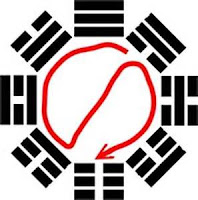The mysterious Big Dipper in Taoism.
For the
benefits of those friends who have practiced the Seven Star Steps, I would now
disclose how the Seven Stars can be utilized in helping our daily rituals.
Below is additional information for your reading pleasure. I have intentionally left out details
of altar set ups and the Taoist ‘guru yoga’ for simplicity. Having said so, this may still be quite difficult to read for many people due to the ritualistic nature of the wordings.
Basically
the Seven Star Steps are performed before Taoist rituals proper for various
reasons. There are 8 methods on how the Seven Star can be used:
First, the ‘top
and bottom steps’ (戴履斗):
This star
steps is used to chase away and to burn out all evil spirits prior to any
Taoist rituals. In performing this star steps, a Taoist should hold a ritual
sword in front of his chest and then walk the star steps. In addition, he/she
should visualize that the Big Dipper (北斗) is on top of his/her head and that he/she is walking on the Big
Dipper. During the star walk, the person should think there is a fire ball at
the tip of his/her ritual sword. This fire ball grows bigger for each step this
person walks until the fire ball chases away all evil spirits.
But let me
just hold you at this point as it is enough to chase away the evil spirits and
not to kill them. So the visualization should stop just right after the spirits
are gone and not letting the sword fire fills the universe!
Second, the
‘meeting the immortal steps’ (朝真斗):
Ideally one
should have a Taoist communication tablet (神简).
In this
exercise one should just imagine that his/her soul is exiting the top of
his/her head while walking the seven steps. This is like the soul is climbing a
ladder to reach to the heavens where the Taoist immortals are staying. After
one’s soul has said what he/she wants, it must descend back into the person’s
body.
Thirdly,
the ‘summoning of heavenly general steps’ (召将斗):
After a
Taoist has met with his/her heavenly masters and obtained approvals, he/she shall
be able to summon the heavenly generals to help in his/her rituals. In this
exercise, the person should again hold his/her ritual sword and walk the seven
star steps while commanding these heavenly entities to obey his/her orders.
The fourth
is the ‘ascending steps’ (升斗):
During and
after the Taoist rituals, a Taoist must keep his/her meditative concentration.
In order to maintain this concentration, he/she should visualize the seven
stars is shining brightly on his/her head protecting him/her form disturbance
of evil entities.
The fifth
is the ‘sleeping steps’ ( 卧斗):
A person’s
soul is the weakest when he/she sleeps. So, in order to prevent spiritual
disturbances during sleep such as hag ride one should imagine that he/she is
blanket by the seven stars.
I often
practise this ‘sleeping steps’ before I sleep and it is an excellent method to
ward off any spiritual interferences.
The sixth
is the ‘house steps’ (舍斗):
This step
is normally used when one meditates same as with the fifth steps.
The seventh
is the ‘remembering guru steps’ (存真斗):
The ‘remembering
guru steps’ is an important procedure because a Taoist shall be able to consult
his/her guru whenever in need or in emergency. In this step, same as with the ‘ascending
steps’, one imagines that he/she has ascended up to heaven and hence accepts
advices from the heavenly masters.
The eighth
step is the ‘subduing steps’ (制伏斗):
When one is
disturbed during meditation by spirits or black magic, then he/she should first
calm his/her mind and imagining that he/she is wearing the seven stars as
clothing and remains in meditative mode. All attacks shall be revoked
automatically.
All of the
above are very brief descriptions on how the Seven Star Steps are used in
ritual and daily life. Traditionally, Taoist rituals are taught face to face
and it is difficult to describe them in detail. I supposed it is sufficient for
the moment until next time.









